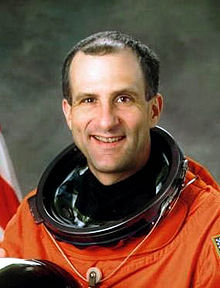- Donald Pettit
-
Donald Roy Pettit 
NASA Astronaut Nationality American Born April 20, 1955
Silverton, OregonOther occupation Chemical engineer Time in space 176d 21h 44m 15s Selection 1996 NASA Group Missions STS-113, Expedition 6, Soyuz TMA-1, STS-126 Mission insignia _ _



Donald Roy Pettit (born April 20, 1955) is an American chemical engineer and a NASA astronaut. He is a veteran of a six-month stay aboard the International Space Station and a six-week expedition to find meteorites in Antarctica.
Contents
Personal
Pettit was raised in Silverton, Oregon, and is an Eagle Scout.[1] He earned a bachelor's degree in chemical engineering from Oregon State University in 1978 and a doctoral degree from the University of Arizona in 1983. He worked as a scientist as the Los Alamos National Laboratory until 1996, when he was selected as an astronaut candidate. He is married and has two sons.
International Space Station
Pettit's first space mission was as a mission specialist on ISS Expedition 6 in 2002 and 2003. During his six-month stay aboard the space station, he performed two EVAs to help install external scientific equipment. During free time on his stay aboard the International Space Station, he conducted demonstrations showing how fluids react in an extremely low gravity environment in a series he called "Saturday Morning Science".[2]
Pettit was Mission Specialist 1 on the STS-126 mission to deliver equipment and supplies to the ISS. He spent 15 days 20 hours 29 minutes and 37 seconds on board Endeavour.[3]
Pettit also performed experiments on board ISS related to clumping of solid particles in microgravity. The experiments showed that particles of various materials which varied in size between 1 micrometer and 6 mm naturally clumped together in microgravity when confined to a volume of 4 liters that included a few grams of the materials. The cause was theorized to be electrostatic. The presents a plausible mechanism for the initial stages of planetary formation, since particles of this size do not have sufficient gravity to cause this phenomenon.[4][5]
Pettit is scheduled to return to ISS in late 2011 as part of the Expedition 30 crew.
Inventions/innovations
 Astronaut Pettit operates barn door tracker he created for ISS-based photography of Earth's surface.
Astronaut Pettit operates barn door tracker he created for ISS-based photography of Earth's surface.
During Expedition 6 in 2002/2003, Pettit used spare parts found throughout the Station to construct a barn door tracker; the device compensates for the movement of the ISS relative to the Earth's surface, permitting sharper high resolution images of city lights at night from the orbiting space station.[6][7]
In November 2008, Pettit invented a zero-g coffee cup, which used the wetting angle to carry the coffee along a crease to permit drinking and avoid the necessity of a straw. This zero-g cup was featured in the May 2009 National Geographic Magazine issue, along with his notes on the relation of the internal cup angle to the contact wetting angle for various construction materials.[8]
Antarctica
From November 2006 through January 2007, Pettit joined the Antarctic Search for Meteorites (ANSMET), spending six weeks in the Antarctic summer collecting meteorite samples,[9] including a lunar meteorite. During the expedition, he was called on to perform emergency electrical repairs to a snowmobile and emergency dental surgery. Periods of tent-confining inclement weather were spent continuing his Saturday Morning Science series—"on Ice"—with photographic surveys of crystal sizes of glacial ice samples and collections of magnetic micrometeorites from ice melt used for cooking water. (He estimated Antarctic glacial ice to contain roughly 1 micrometeorite per liter.)
References
- ^ "Astronauts and the BSA". Fact sheet. Boy Scouts of America. http://usscouts.org/usscouts/eagle/eagleastronauts.asp. Retrieved 2010-09-16.
- ^ http://spaceflight.nasa.gov/station/crew/exp6/spacechronicles_videos.html
- ^ Schwartz, John (2008-11-14). "Handyman to Return to His Space Workshop". The New York Times. http://www.nytimes.com/2008/11/14/science/space/14pettit.html. Retrieved 2009-08-31.
- ^ "FAST, REPEATABLE CLUMPING OF SOLID PARTICLES IN MICROGRAVITY". S. G. Love and D. R. Pettit. http://www.lpi.usra.edu/meetings/lpsc2004/pdf/1119.pdf. Retrieved 2010-05-29.
- ^ "Building Planets in Plastic Bags". Sky and Telescope. http://www.skyandtelescope.com/news/3308986.html?page=1&c=y. Retrieved 2010-05-29.
- ^ Cindy Evans & Will Stefanov. "Cities at Night: The View from Space". NASA. http://earthobservatory.nasa.gov/Features/CitiesAtNight/. Retrieved 2009-08-31.
- ^ "Space Station Astrophotography". NASA. http://science.nasa.gov/headlines/y2003/24mar_noseprints.htm. Retrieved 2009-08-31.
- ^ Charlie White. "Astronaut invents coffee cup for a weightless cup o' joe". http://dvice.com/archives/2009/02/astronaut_inven.php. Retrieved 2009-08-31.
- ^ "Don Pettit Goes to Antarctica". 2006-12-11. http://science.nasa.gov/headlines/y2006/11dec_donpettit.htm. Retrieved 2007-09-21.
External links
NASA Astronaut Group 16, "The Sardines", 1996 Pilots Duane G. Carey · Stephen Frick · Charles O. Hobaugh · James M. Kelly · Mark Kelly · Scott Kelly · Paul Lockhart · Christopher Loria · William C. McCool · Mark L. PolanskyMission Specialists David M. Brown · Daniel C. Burbank · Yvonne D. Cagle · Fernando Caldeiro · Charles J. Camarda · Laurel B. Clark · E. Michael Fincke · Patrick G. Forrester · John B. Herrington · Joan E. Higginbotham · Sandra H. Magnus · Michael J. Massimino · Richard A. Mastracchio · Lee M. E. Morin · Lisa M. Nowak · Donald R. Pettit · John L. Phillips · Paul W. Richards · Piers J. Sellers · Heidemarie Stefanyshyn-Piper · Daniel M. Tani · Rex J. Walheim · Peggy A. Whitson · Jeffrey N. Williams · Stephanie D. WilsonInternational Mission Specialists NASA Astronaut Groups · NASA Astronaut Corps Categories:- 1955 births
- Living people
- American astronauts
- Oregon State University alumni
- University of Arizona alumni
- Eagle Scouts
- People from Silverton, Oregon
- Crew members of the International Space Station
Wikimedia Foundation. 2010.
